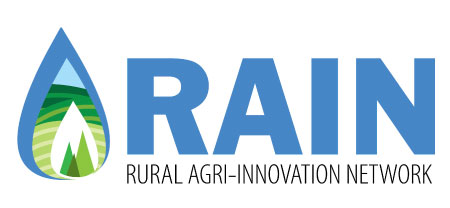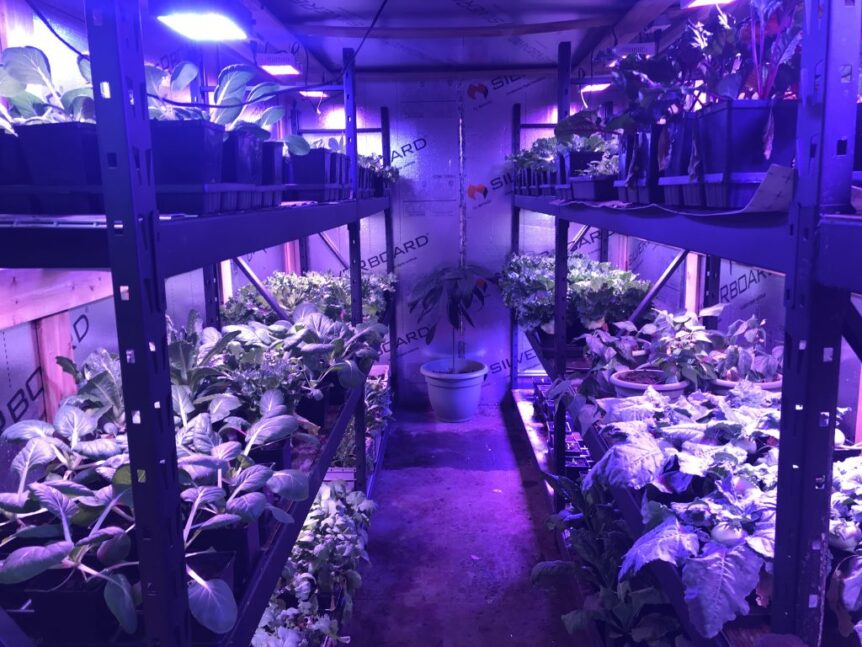Four-season growing in Algoma just got a whole lot easier. Colin Templeton, of the Food Bank Farm, puts forth a solution to the lack of winter growing opportunities in Northern Ontario.
Last August (2020) Colin set up, what he calls, an indoor growth facility. The growth facility is constructed from a repurposed shipping container fitted with shelving, LED grow lights and insulation.
David Thompson, Manager of the Rural Agri-Innovation Network (RAIN) was on-site at the Food Bank Farm to check out this innovative growing technique.
About the Food Bank Farm
The Food Bank Farm was started by Colin Templeton and Isabelle Trottier-Saucier. The pair started out as market gardeners who donated a certain amount of each harvest to food banks in Sault Ste. Marie. The farm quickly transformed into a food bank farm when Colin and Isabelle realized the community’s dire need for accessible, local produce. The farm is the first of its kind in Canada where 100% of everything that is grown is donated to local food banks. The farm can produce about 15,000 pounds of food every year, but only operates outdoors during the summer months. A year-round indoor growth facility was a natural next step for the Food Bank Farm, whose objective is “to reduce the impact of poverty by improving food security, health and welfare of individuals and families through the delivery of high-quality fresh vegetables.”
Growth Facility Construction
Colin constructed the indoor growth facility, made from a repurposed shipping container, and has utilized the indoor growing space for its first winter season. The facility costs around $15,000 to construct – $5,000 for the container itself, $5,000 for the lights, and $5,000 for the shelving and insulation. Colin mentions the superior sturdiness of the shipping container as one of the main reasons why they work so well in the harsh Algoma winters. Unlike greenhouses made from plastic or glass, the metal walls and roof will not bend or break under the pressure of accumulated snow. The shipping container is insulated to a value of r15. The facility can stay at a suitable temperature with no other heat source other than the LED lights; even when it is minus 30 below outside. The facility was created as a demonstration to show people that four-season growing in Northern Ontario is not only possible but simple and cost-effective compared to commercial systems that use hydroponics and can cost upward of $100,000 in startup costs. The facility operates on about $5 of electricity per day.
Growing Fresh Produce
Inside the growth facility plants are grown in ordinary pots with potting soil and fertilizer. Colin says that it is akin to growing house plants. The facility can produce 75 to 100 heads of lettuce per week. Varieties that grow well outside do not necessarily grow well inside under grow lights. After many trials, they found that Summer Crisp lettuce, bok choy, spinach, radishes, kale, and kohlrabi grow the best inside the shipping container. Colin emphasizes that the most important aspect of the indoor growth facility is that it allows Food Bank Farm to provide fresh, quality, local produce all winter long, as cost-effectively as possible.
Sharing knowledge
The Food Bank Farm sees the facility as a learning opportunity for the community. Anyone interested in four-season growing in Sault Ste. Marie is welcome to visit the farm to see what they have been able to accomplish. Aside from onsite visits, Colin, partnered with Algoma University, has created an upcoming construction manual. The manual is a step-by-step guide to how the facility was built and how the project was successfully completed from start to finish.
The next steps for Colin include continuing to operate the facility, continuing to refine the growing system, and continuing to find varieties that perform well under the LED lights. Colin plans to continue working with Algoma University to get the word out about this project and to provide opportunities for people to visit if they wish to develop something similar.
For more information about the Food Bank Farm and this project can visit: https://foodbankfarm.ca/
https://livinglabs.lakeheadu.ca/partner-organizations/algoma-university/the-food-bank-farm-and-algoma-university-cooperation/
Upcoming Greenhouse Development/Vertical Farm Webinars
May 6, 11:00 a.m. – 4:30 p.m. EST: Greenhouse Production
May 13, 11:00 a.m. – 3:45 p.m. EST: Vertical Farming
As technology becomes available, new crops and production methods are expanding opportunities in Northern Ontario.
Learn from the experts about some of the key things to consider when starting a project, what resources are available to help you on your way, and how municipalities can play a role in supporting sector growth.
Presented by the Ontario Ministry of Agriculture, Food and Rural Affairs, and the Ontario Ministry of Energy, Northern Development and Mines
To register, visit: https://www.nofia-agri.com/greenhouse-vertical-farming
If you require assistance with registering please contact the Agriculture Information Contact Centre by email: ag.info.omafra@ontario.ca or by phone: 1-877-424-1300.
If you have questions about these webinars please contact Jason Felix, Trade and Investment Specialist with the Ministry of Energy, Northern Development and Mines by phone: 807-936-0487 or email: jason.felix@ontario.ca. You can also reach out to Kendal Donahue, Agriculture Development Advisor with the Ontario Ministry of Agriculture, Food and Rural Affairs by phone: 807-627-1566 or email: kendal.donahue@ontario.ca.

